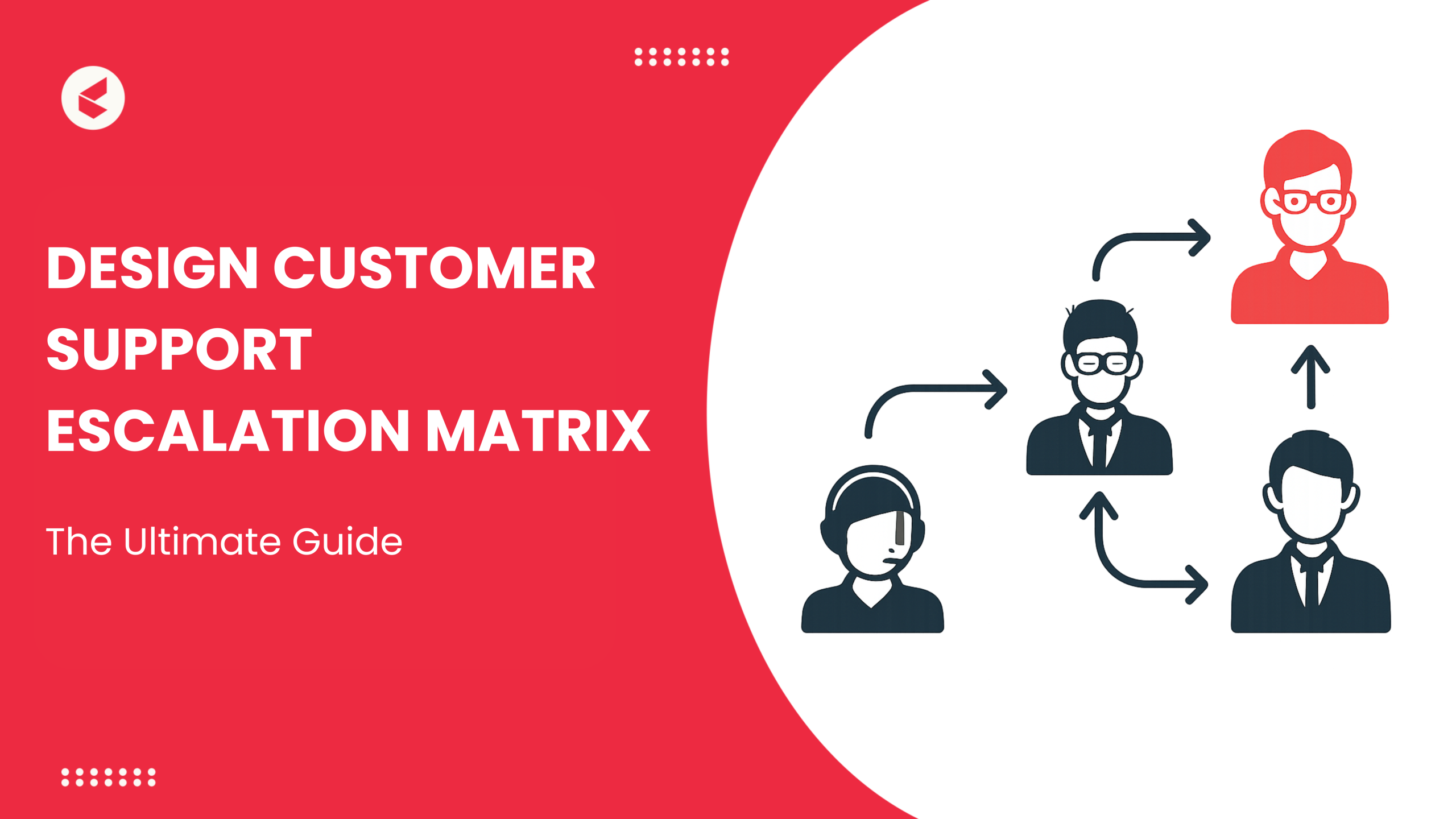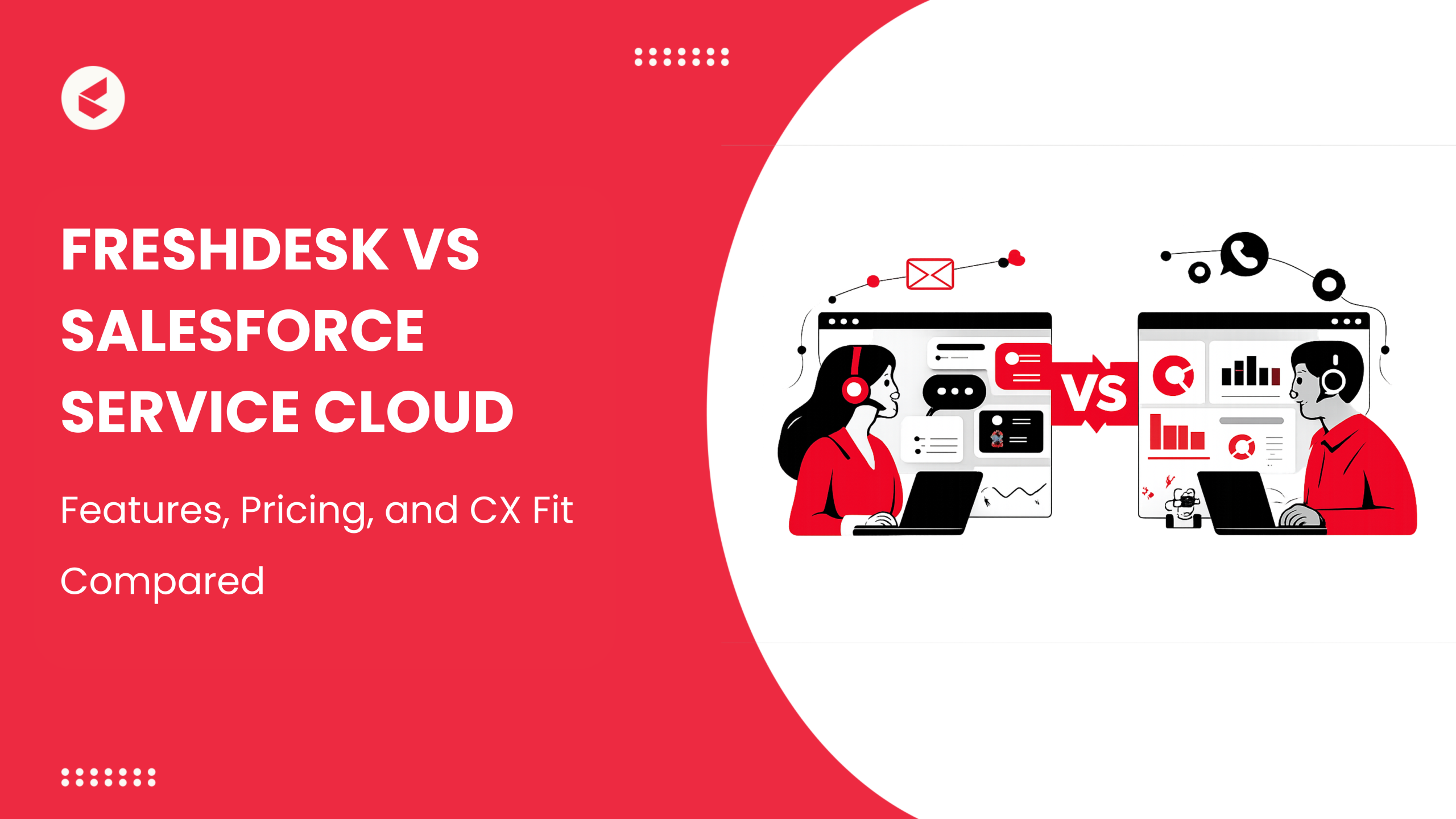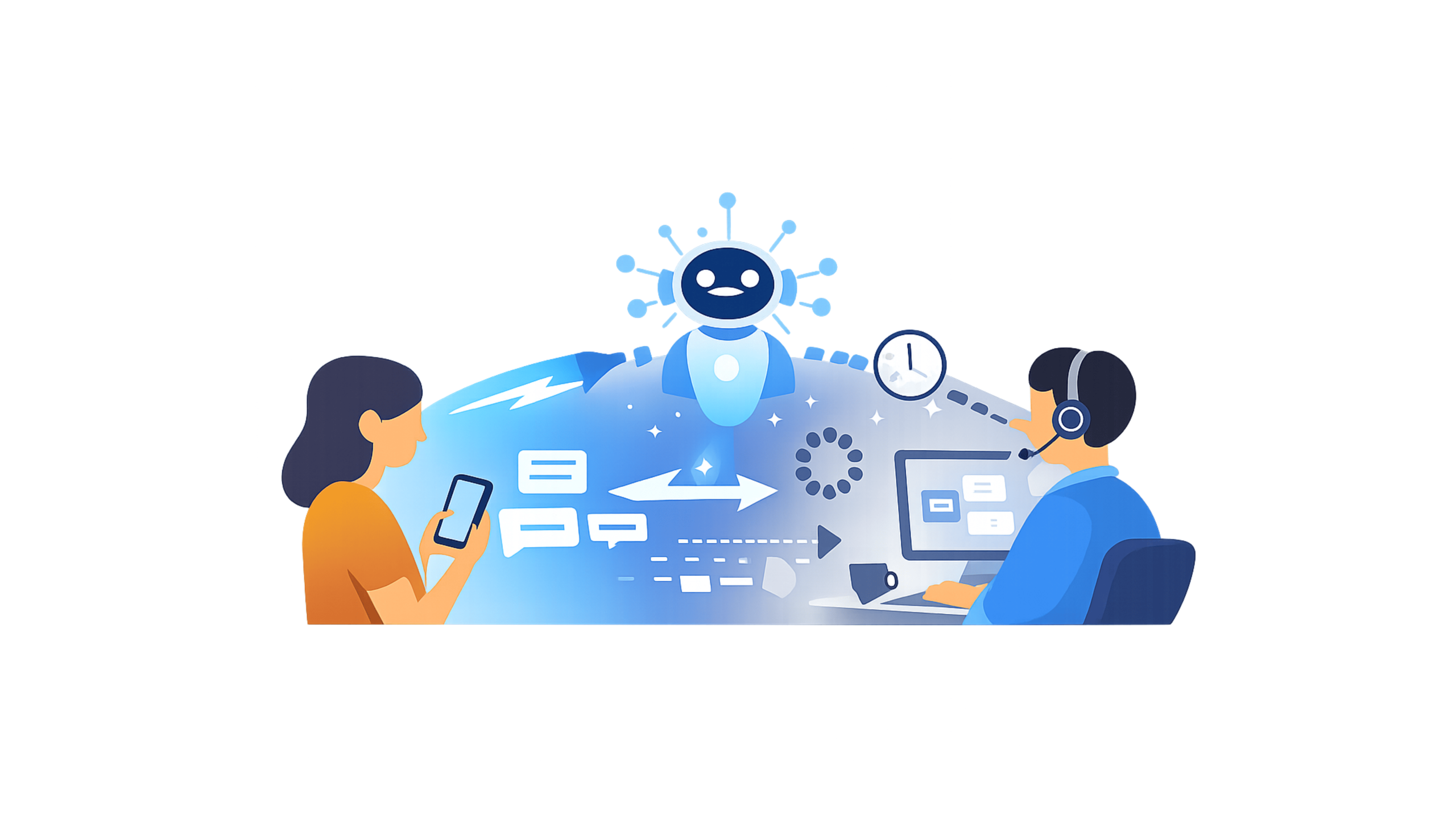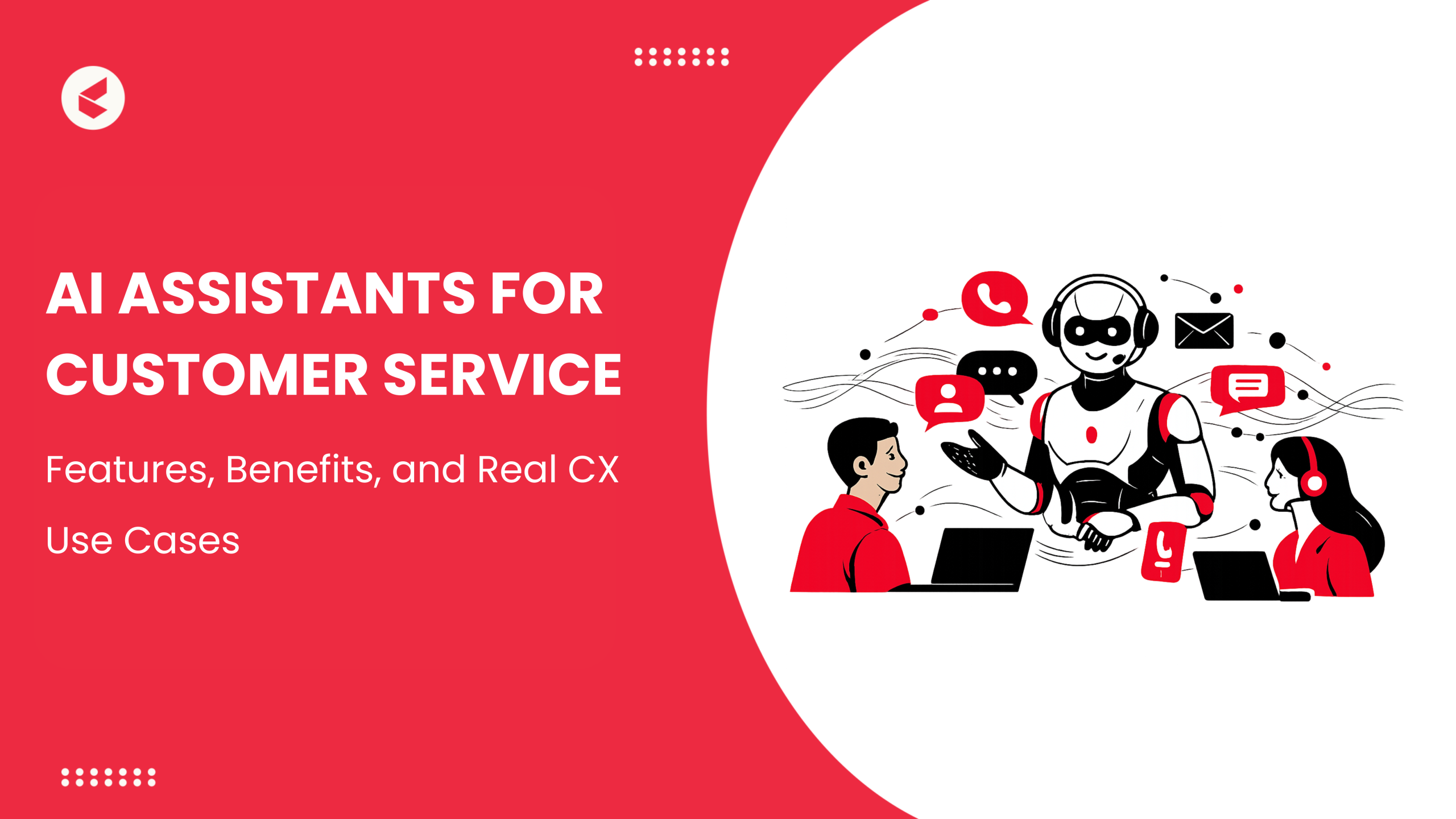“Between an uncontrolled escalation and passivity, there’s a demanding road of responsibility that we must follow.”
–Dominique De Villepin (Former Prime Minister of France)
Keeping your customers happy while offering them the best experience possible is instrumental to making your business prosperous. A customer support escalation matrix for service support can help in this regard as for customer support teams, it is the backbone of a seamless ticket escalation process, helping them identify when, how, and who should handle inquiries at different levels of complexity.
It is designed to provide clarity to the problem, reduce wait time, and resolve tickets as soon as they reach the system. Aside from quick turnarounds, the organization maintains solid client relationships and, of course, saves money.
An escalation matrix for service support format is a system within a comprehensive service ticket automation platform that identifies when an inquiry should be escalated and who should handle incidents at each escalation level.
In this article, we will be discussing how you can use a customer support escalation matrix to increase your ROI, as well as how to optimize it.
When a service ticket is filed, an escalation process takes place with a structured flowchart approach that specifies which departments and individuals should be contacted and in what order of hierarchy. It also determines when the issue should be escalated further to address the problem efficiently and then acquire the required resolution.
Depending on the scenario, a dummy matrix is created of a succession of steadily rising levels of contact. The purpose of any matrix is to have a real face-to-face conversation with the most proactive support team member who can provide help at any hour of the day, without letting the system attend it.
As soon as the escalation reaches a higher level of authority, the wait time increases, and the problem remains unsolved. It’s important to prioritize and attend to every issue raised at the same time before it shifts lower in the list.
Why Should Teams Utilize a Customer Escalation Matrix?
An escalation matrix for service support is a structured roadmap for customer support teams, guiding them through which departments and employees should be contacted based on the service ticket’s escalation level.
It is a hallmark of foresight and good project management that gives the following results in the longer term:
- Elevated retention rates of customers.
- Increased loyalty, repeated purchase, and CSAT
- Lower Turnaround Time, which directly increases process efficiency.
- Organized hierarchical management flow.
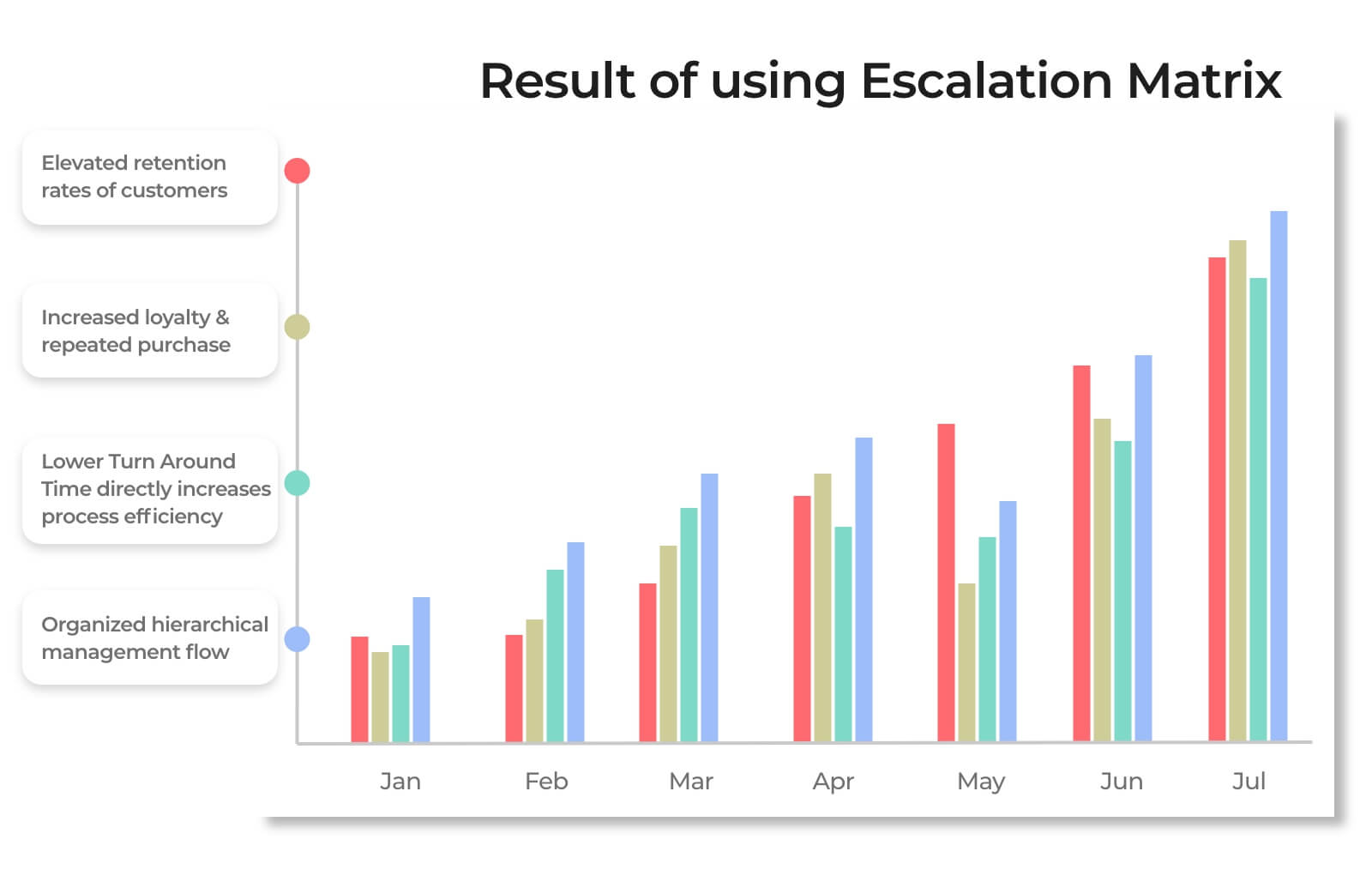
In customer service, escalation matrices for service support are segregated based on the strategy they follow chronologically. Customer support teams use it as a blueprint to fine-tune their approach towards support ticket escalation issues. To help you understand them better we have categorized them into 3 segments –
1. Hierarchical Escalation: When an occurrence of an event is forwarded to a team or person depending on their expertise or seniority inside the organization, it is referred to as hierarchical escalation.
For instance, there’s a customer on-call with a tier 1 agent who is addressing a complicated refund issue. In a hierarchical structure, if they can’t resolve the issue, the agent will escalate it to the supervisor or further on to the account manager until it is resolved.
2. Domain-Centric Escalation: A ticket will be directed to the team or individual who has the exact competence needed to resolve the significant concern, even if they aren’t the next in line hierarchically.
The pre-sales employee, for example, if A is senior to B, B would still be the best individual to deal with the situation at hand.
In a software development company, a bug is reported by a client that’s affecting the payment processing functionalities of the platform. The customer support team instead of escalating it to a senior support engineer, they instead assigns it to the payments module expert, even though they are hierarchically at a junior level because they have the exact technical expertise needed to resolve this exact problem.
3. Priority Escalation: An escalation based out of priority triggers keywords that identify inquiries that are urgent and critical (measured by a metric of low, medium, and high ratings). It can be a comment, an email, or feedback by a client/customer that is connected to the relevant support team to be addressed faster in order of priority and importance.
At Kapture, this is an efficient ‘Conflict Management and Resolution Technique’ that is used to detect and competently resolve high-priority issues.
For example, a customer raises a ticket with the subject ‘Delayed Product Delivery’ as a keyword. As soon as the system recognizes the word ‘Delayed’, a trigger assigns it to ‘High’ priority and escalates it to the concerned customer support team that can resolve the issue.
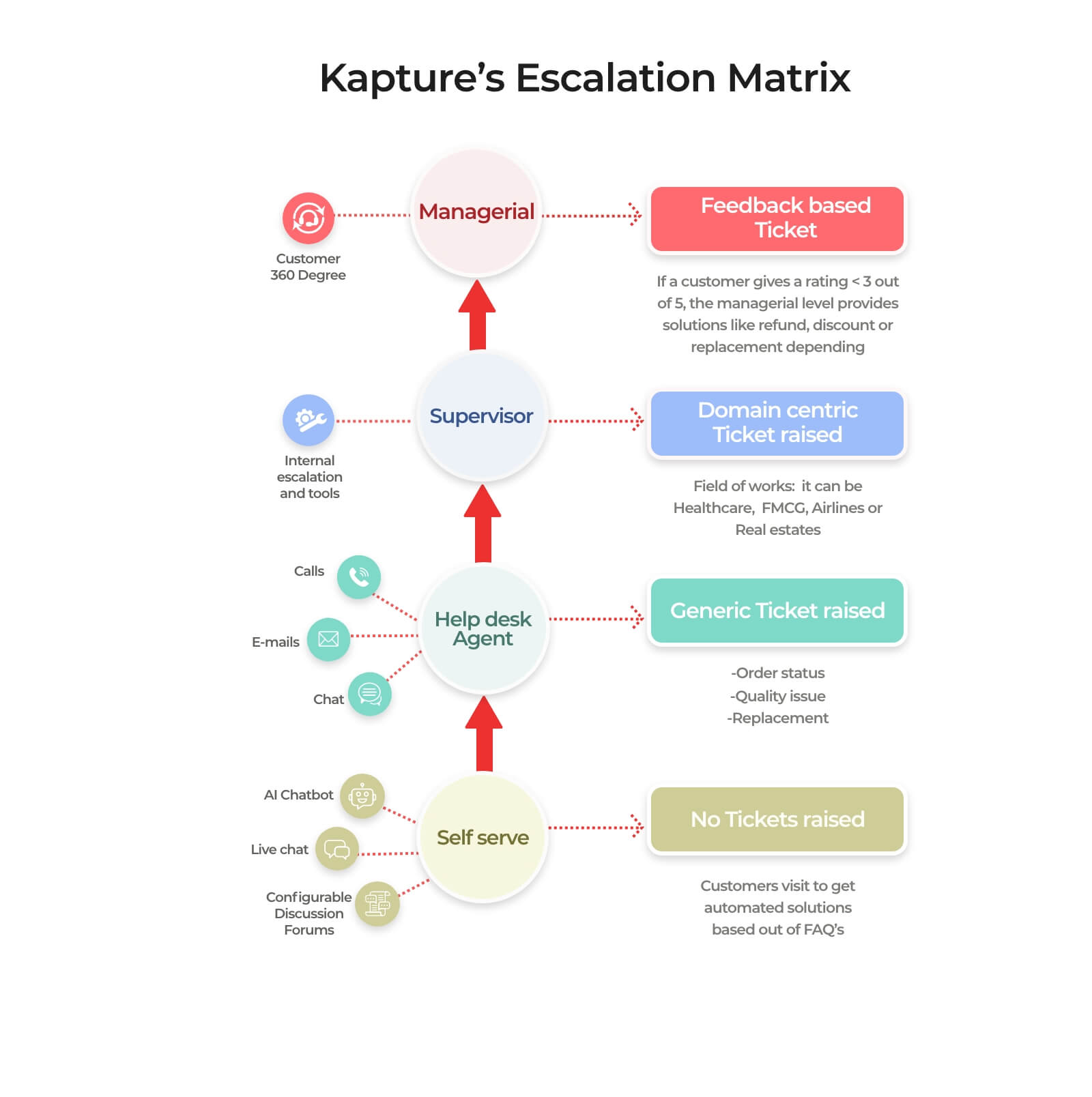
How to reduce your Escalation Rate?
There are customer support teams that are able to achieve First Call Resolution (FCR) more quickly than those that have a higher escalation rate. The factors that can affect the latter can range from anything to peak hours, high call volumes, industry type, or direct requests for an escalation. However, it is in the company’s best interest to maintain a low escalation rate regardless of the factors mentioned above.
How can this be achieved?
- Understand when it is the most opportune time to increase the time limit for attending a query, depending on the problem.
- Have a thorough understanding of your Service Level Agreement (SLA) and Service Level Objective (SLO).
- Install a well-scheduled ticketing helpdesk tracking system that helps in mapping the tickets that must be attended on a particular day by an assigned agent.
- If a call requires task dependency, then arrange a solution based on suggestions made by other departments.
- Enabling automatic conversational filtered options based on repeated use cases.
Furthermore, Kapture provides this unique feature where 3rd party vendors can be immediately contacted by tagging them in the same ticket where the problem is raised and escalation support is needed. The routing techniques are divided into four parts:
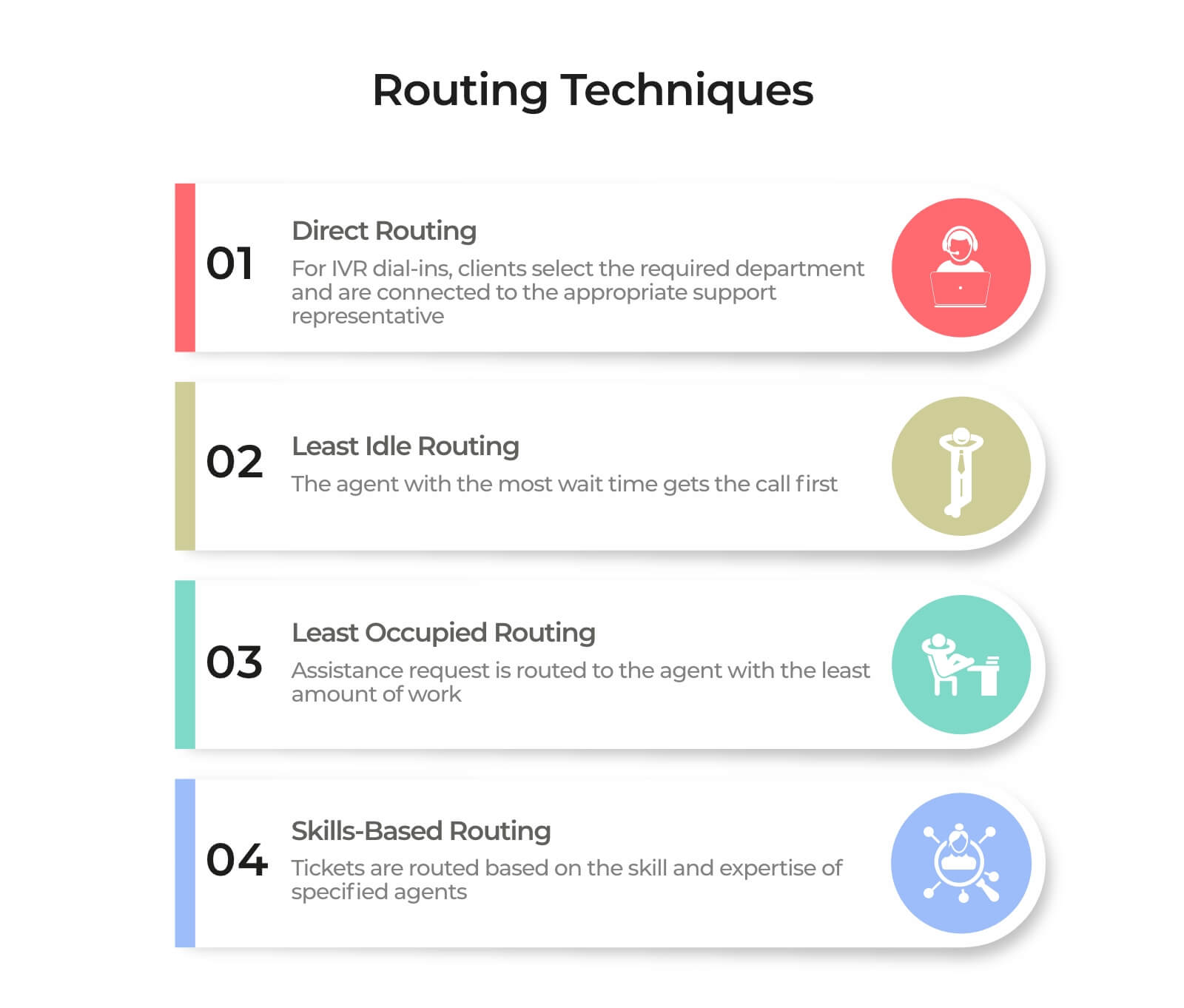
Steps to handle an Escalation:
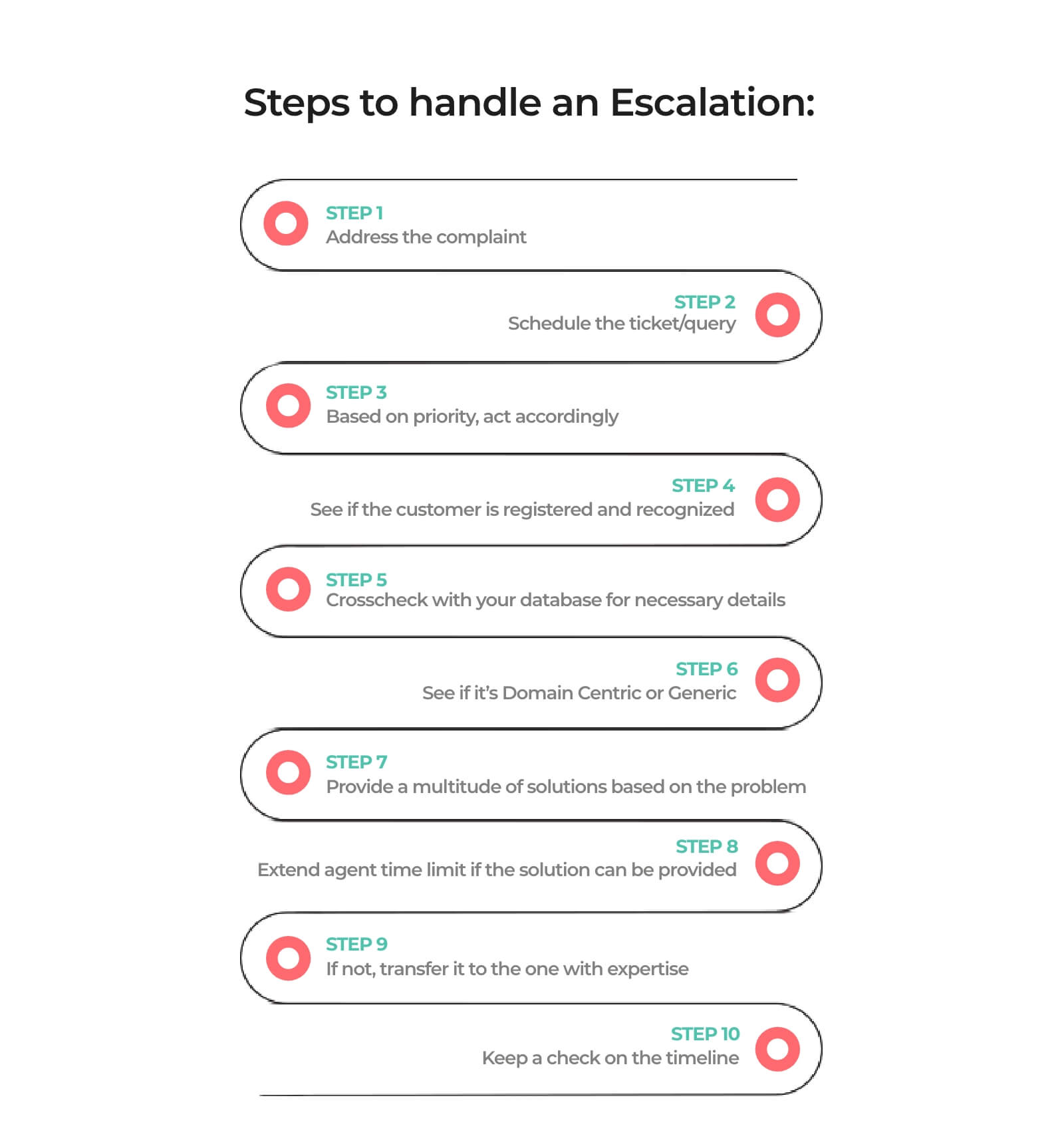
How Customer Support Escalation Matrix helps in different industries?
The escalation matrix for service support is a versatile tool across industries, fostering customer relationships and driving sales. In sectors like technology, retail, banking, and travel, it aids in understanding client needs and improving experiences. This framework enables businesses to strategize effectively by prioritizing touchpoints.
In IT, the escalation process addresses issues promptly through proper monitoring, ensuring timely resolution. Customer service escalations, stemming from miscommunication or technical glitches, require effective management to uphold a positive customer experience.
In e-commerce, the escalation matrix enhances sales and conversions. In banking, it categorizes issues for swift resolution, while in travel, it targets key leads, utilizing tailored strategies to capture attention in the digital era.
Types of Escalation Matrix Templates for Service Support
There’s no one-size-fits-all escalation matrix for service support format. Depending on your team structure, SLAs, and customer expectations, you can pick from different templates or even combine them. Here are some practical formats you can start with.
1. Level-Based Escalation Matrix (L1 → L4)
This is the classic escalation matrix for service support where tickets move from frontline agents to more specialised or senior teams based on complexity.
Use this template when:
- You have clearly defined support levels (L1, L2, L3, L4).
- You want a simple, hierarchical view of “who handles what and when”.
Example format:
| Severity | Level 1 Owner | SLA (Response/Resolution) | Escalate To (Level 2) | Final Escalation (Level 3/4) |
|---|---|---|---|---|
| Low | L1 Support Agent | 4 hrs / 24 hrs | Team Lead | Support Manager |
| Medium | L1 Support Agent | 2 hrs / 12 hrs | Product Specialist (L2) | Head of Customer Support |
| High | Senior Support Agent (L1.5) | 30 mins / 4 hrs | Incident Manager (L2) | CX / Operations Head (L3/L4) |
| Critical | Senior Support + On-call L2 | 15 mins / 2 hrs | Incident Manager + Tech Lead | CXO / Business Stakeholder |
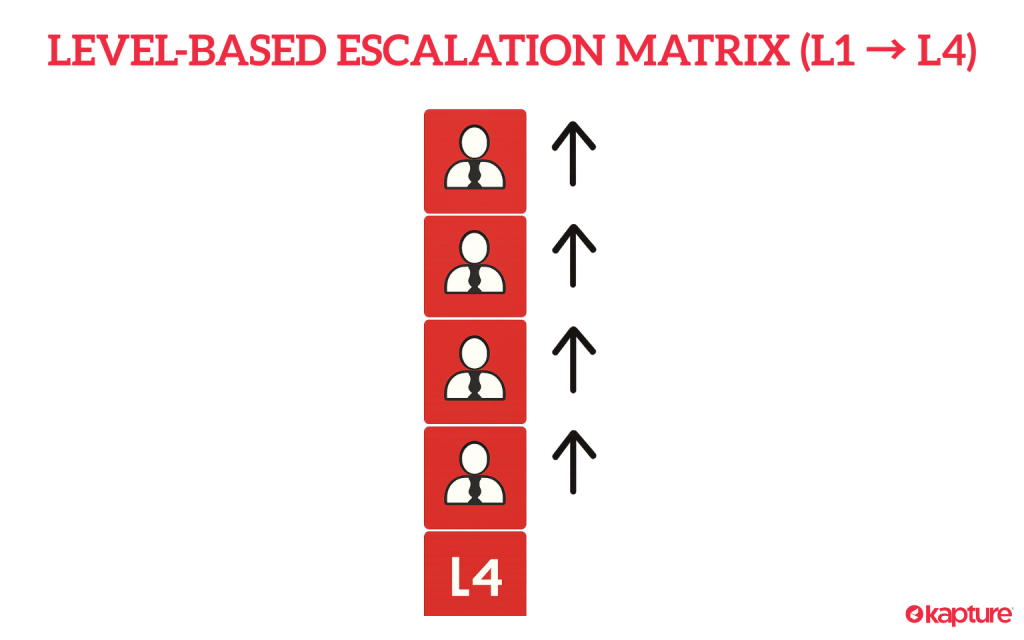
2. Priority & SLA-Based Escalation Matrix
Here, the escalation matrix format is driven primarily by priority and time — what happens if an issue isn’t resolved within the agreed SLA.
Use this template when:
- SLAs are strict and time-bound.
- “When do we escalate?” is more important than “Who’s more senior?”
Example format:
| Priority | Initial Owner | Response SLA | Resolution SLA | Escalate If Breached To | Escalation Time Window |
|---|---|---|---|---|---|
| P1 – Critical | Incident Manager | 15 mins | 2 hrs | Head of Customer Support | If not resolved within 1 hr |
| P2 – High | Senior Agent | 30 mins | 4 hrs | Team Lead | If not resolved within 2 hrs |
| P3 – Medium | L1 Agent | 2 hrs | 24 hrs | Team Lead | If not resolved within 12 hrs |
| P4 – Low | L1 Agent | 4 hrs | 48 hrs | Queue Owner | If not resolved within 24 hrs |

3. Domain / Function-Based Escalation Matrix
This escalation matrix for service support format recognises that the right expert matters more than strict hierarchy. Tickets are routed to teams based on domain (billing, logistics, technical, KYC, etc.).
Use this template when:
- You have specialised teams or pods.
- You want to reduce back-and-forth by routing issues straight to domain experts.
Example format:
| Issue Type | Level 1 Owner | Level 2 (Domain Expert) | Level 3 (Final Escalation) |
|---|---|---|---|
| Login / Access | L1 Support Agent | Tech Support | Engineering Lead |
| Billing & Refunds | L1 Billing Support | Finance / Billing Specialist | Finance Manager |
| Delivery / Logistics | L1 Order Support | Logistics / Ops Team | Operations Head |
| KYC / Compliance | L1 Support Agent | Compliance Team | Compliance / Risk Head |

4. Channel-Based Escalation Matrix (Email, Chat, Voice, Social)
Some brands have different SLAs and owners for each channel. This template shows how escalations behave per channel.
Use this template when:
- You support multiple channels and each has different expectations.
- Social or voice needs faster escalation than email.
Example format:
| Channel | Level 1 Owner | Response SLA | Escalation Path |
|---|---|---|---|
| Email Support Queue | 2 hrs | L2 Support → Team Lead → Support Manager | |
| Chat | Live Chat Agents | 2 mins | Chat Lead → Incident Manager |
| Voice | Call Center Agents | 1 min | Floor Supervisor → Incident Manager |
| Social | Social Media Team | 15 mins | Brand Manager → CX / PR Lead |

5. Customer Tier / Impact-Based Escalation Matrix
Here, the template prioritises escalation based on customer tier (Enterprise, SMB, VIP, etc.) and business impact.
Use this template when:
- You serve multiple customer tiers.
- Certain accounts (VIP/enterprise) need faster, more senior attention.
Example format:
| Customer Tier | Impact Level | Initial Owner | Escalation Owner | Notes |
|---|---|---|---|---|
| Enterprise | High | Key Account Support | Customer Success Manager | Immediate phone + email |
| Enterprise | Medium | L1 Support Agent | Account Manager | Escalate if open > 4 hrs |
| SMB | High | L1 Support Agent | Support Team Lead | Escalate if open > 6 hrs |
| SMB | Low | L1 Support Agent | Queue Owner | Normal SLA applies |

Escalation Matrix: A much-needed solution
It is the obligation of management to continuously evaluate any occurrences of ticket escalation using the right escalation matrix format for service support whether it is an agitated caller, an agent who needs further training, or any other issue. All instances must be examined in order to determine the grounds for the escalation management team to proceed further.
To limit the frequency of escalated tickets, agents, executives or supervisors should also actively follow up on any previous occurrences to find methods to improve future scenarios of a similar nature.
A well-designed escalation matrix for service support can help develop techniques to install the perfect Help desk software. It also helps to avoid misunderstandings between employee roles and project goals as well as illustrates how your features create clarity within the internal team for better workflow and productivity.
At Kapture, we have developed an intelligent and contextual ‘Ticket Management System’ which is constantly evolving to provide improved accountability, delightful customer service, and increased overall customer satisfaction.
Know more about how Kapture handles escalations and delivers results at: – Ticket Management Software
Book your demo today and mark your brand’s identity in this competitive market with efficient CX software.
FAQ’s
Client escalation happens when a client is dissatisfied with the level of service which has been provided by the company and as a result decide the support agent has no other choice but to transfer the issue to his higher-ups
An escalation matrix gives structure to customer support teams on how to ideally handle c customer complaints. It outlines the personnel responsible for handling issues based on the nature and severity of it.
A well-designed escalation matrix includes:
• Issue classification: Defines problem severity levels.
• Escalation levels: Identifies who handles issues at each stage.
• Response timeframes: Set deadlines for resolution at each level.
• Communication protocol: Specifies how escalations are logged, tracked, and updated.
An escalation matrix makes certain that customer issues are handled by the people with the best expertise pertaining to the issue faced which in turn would lead to it getting sorted out quickly and the customer being all the more happy for the outcome
Customer support escalations can be categorized into:
• Hierarchical Escalation: The issue moves up to higher management or senior team members.
• Domain-Centric Escalation: The case is assigned to someone with the right expertise, regardless of rank.
• Priority Escalation: Urgent matters are flagged and fast-tracked based on severity.
To keep escalation rates low, businesses can:
• Train support agents to handle issues on the first attempt.
• Set up clear Service Level Agreements (SLAs).
• Use automated helpdesk tools to track and manage tickets.
• Implement smart routing so tickets reach the right person immediately.
Different industries benefit from escalation matrices in unique ways:
• IT & Software: Ensures system issues and bugs are resolved quickly.
• E-commerce: Helps manage complaints about late deliveries, refunds, or product concerns.
• Banking: Speeds up resolutions for transaction disputes and security issues.
• Travel & Hospitality: Prioritizes urgent booking or refund issues to improve customer experience.
,
,
,
,
,
,
,
,
,
,
,
,
,
